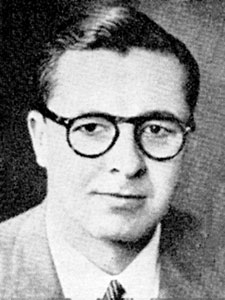Devises New Method For Correcting Photocomposed Type

W.W. Davidson, Jr., President of the Davidson Co., Division of Mergenthaler Linotype Co., Brooklyn, N.Y.
The problem of making corrections in photocomposed type, long considered an unwieldy and unsatisfactory process, may be eased considerably by a new method developed by William W. Davidson, Jr. On July 3, Patent No. 3,041,930 was issued to Mr. Davidson for an “apparatus and method for simplified photocomposition corrections.”
This correction system is claimed to work equally well with any of the present methods of photographic typesetting and composition. Presently, lines of photocomposed type containing errors have to be recomposed, developed, fixed, and dried before the correction process can begin. Then the new line is laboriously inserted into the film containing the rest of the composed page either by welding or attaching with an adhesive tape. The only other way is to recompose the whole page.
Mr. Davidson’s method does away with all this by mechanically blocking out the lines containing errors and replacing them with new lines composed directly by the keyboard operator. All other lines needing no corrections are simply photographically copied intact. A page of type can be opened up by inserting more space between lines or closed up by taking out space. The result is a complete, new, unbroken, corrected film (or paper), either positive or negative, and ready for platemaking. The time required is only that needed to recompose those lines in which errors occur.
The process uses dimensionally stable, thin-base film or paper. With the Davidson method, photocomposition corrections, for the first time, are said to be made with the same speed as cast metal type.
This development may be of significant importance to the printing industry. The growth of photocomposition over the last 10 years has been considerable. The economies and speed which it offers the printer and publisher have been important factors in its introduction in the trade. However, since its first use on a large, commercial basis. the handling of corrections and the efficient use of film have been major drawbacks.
Patching in corrections takes the skill of a fine craftsman and can often be costly, thereby defeating some of the original advantages. While photocomposition had reduced type composition to a largely mechanical operation, corrections required more skill than was needed in hot metal.
Mr. Davidson has long been associated with engineering in the printing trades. W. W. Davidson, his father, developed the Davidson Dualith offset printing press. The junior Mr. Davidson contributed several engineering refinements to the Dualith and holds a number of patents in the printing industry. He considers his apparatus and method for simplified photocomposition corrections his most significant achievement.
This article first appeared in the September 1962 issue of The Inland Printer/American Lithographer. Although uncredited, it is most likely written by Alexander S. Lawson.